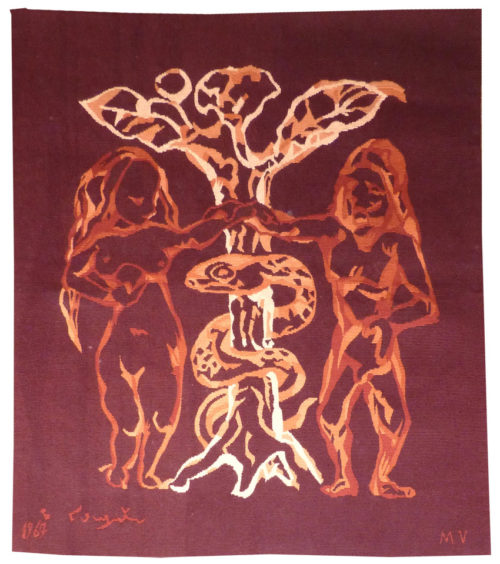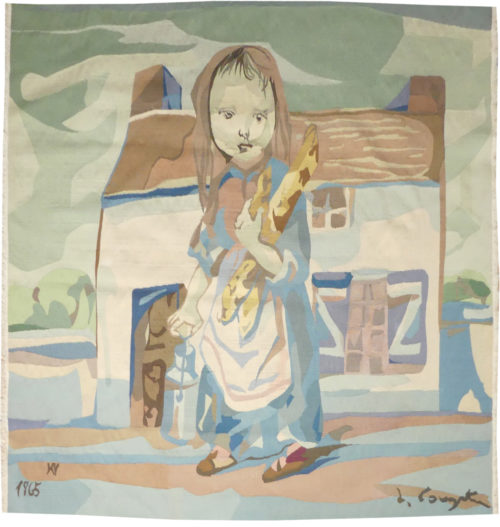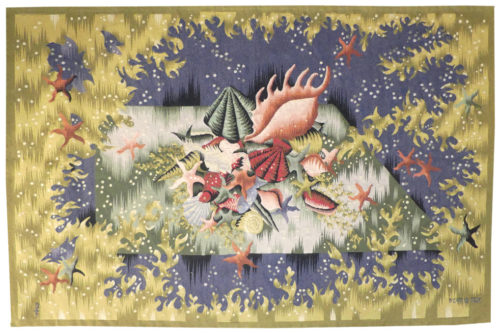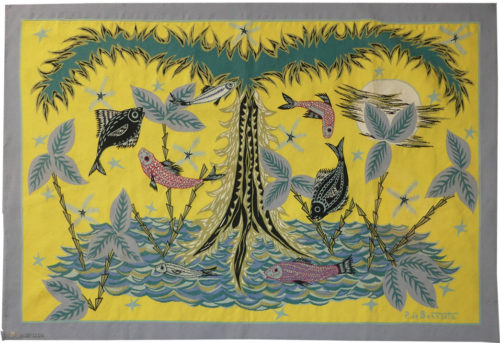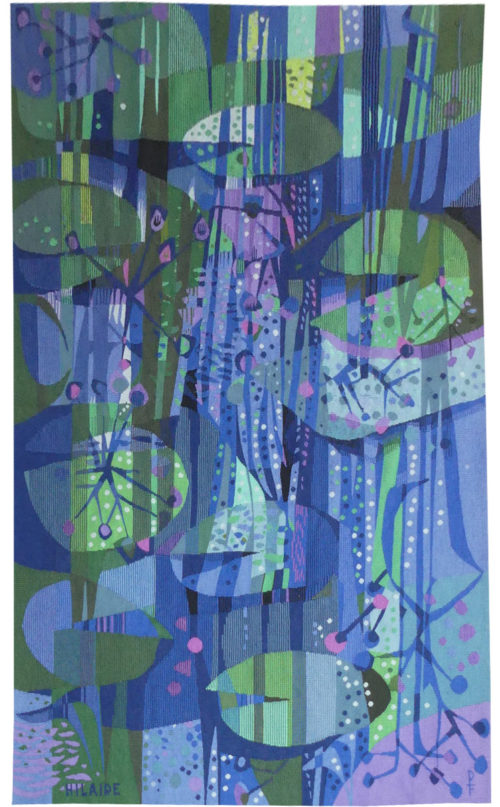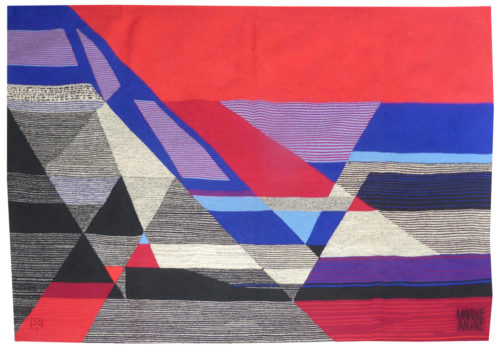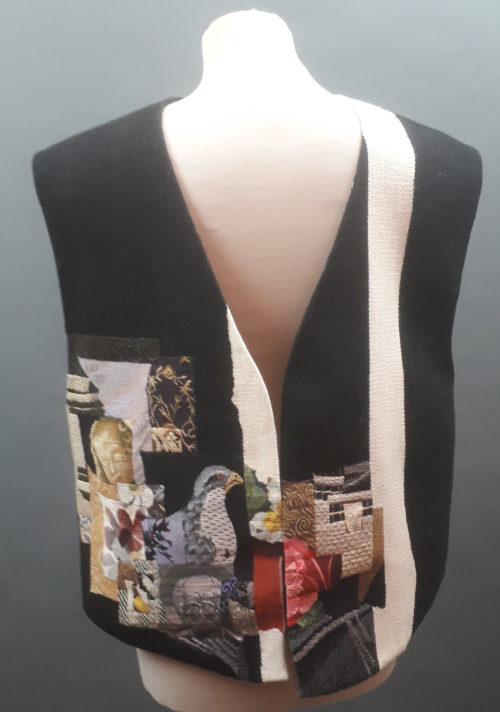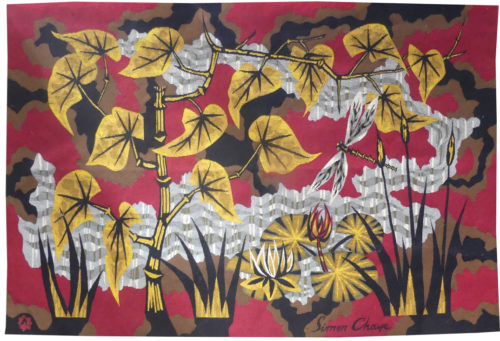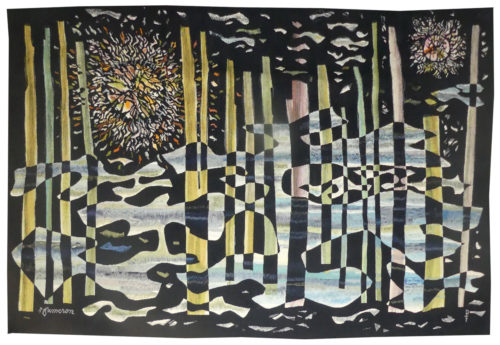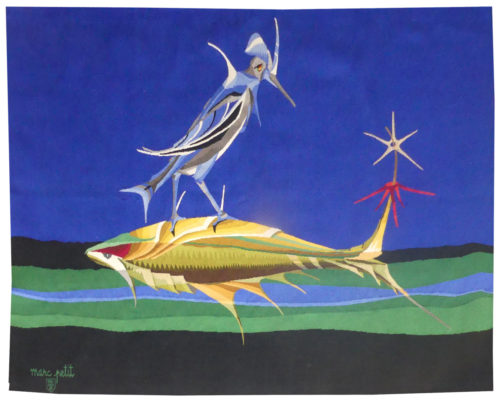-
Foujita is one of a number of artists whose work was woven at Bièvres at the Moulin de Vauboyen (hence the mark MV woven into the tapestries), which was transformed by Pierre de Tartas into an arts centre in 1959 and devoted to figurative art. Many noteworthy names would pass through including Cocteau, Foujita, Erni, Volti ... among others, who would produce much work, often monumental, as well as realisations in the applied arts (notably book illustrations) Foujita realised only a few tapestry cartoons, all of which were produced at Bièvres by Pierre de Tartas. In this particular case, unlike the rest of his production, his style is different from that of his paintings : almost monochrome, stylised (quite different from the lithe brushwork of the artist); as for the biblical theme, it can be seen as the result of his recent conversion to catholicism. Another tapestry, of similar dimensions and subject matter, but in a differing, lighter colour scheme, was also woven at Bièvres.
-
Foujita is one of a number of artists whose work was woven at Bièvres at the Moulin de Vauboyen (hence the mark MV woven into the tapestries), which was transformed by Pierre de Tartas into an arts centre in 1959 and devoted to figurative art. Many noteworthy names would pass through including Cocteau, Foujita, Erni, Volti … among others, who would produce much work, often monumental, as well as realisations in the applied arts (notably book illustrations) Foujita realised only a few tapestry cartoons, all of which were produced at Bièvres by Pierre de Tartas. This one (an original watercolour 147 x 157 cm) was sold on 8th December 2015 by Tajan, and another preparatory drawing appeared in the Kimiyo Foujita succession (Cornette de St Cyr, 28th October 2013, n°167c). Likenesses of children become (even more) common in the period post 2nd world war : all with the same physical type a large forehead, widely spaced eyes, thin nose, full lips and regularly represented in slightly archaic roles redolent of Poulbot’s work.
Marchande de lait (Milkmaid)
Tapestry woven in the Moulin de Vauboyen workshop. 1965. -
Tropiques (Tropics)
On returning to France in the 1950’s after a lengthy period spent in Argentina, Berroeta produced quite a number of cartoons in a style which was first figurative (animals, human figures,...) then turned to abstraction, as in his paintings. The influence of cubism and a lyrical sense of colour cohabit here in a cartoon which could be seen as a reminiscence of South America.Aubusson tapestry woven in the Pinton workshop. Circa 1955. -
Les nymphéas (the waterlilies)
Aubusson tapestry woven in the Pinton workshop for the Verrière gallery. With label, n°4/6. 1968.With a taste for the large-scale, influenced by Untersteller at the Ecole des Beaux Arts, Hilaire undertook numerous mural paintings. In the same vein, beginning in 1949, along with a number of other artists stimulated by Lurçat, (he would join the latter at the A.P.C.T. Association des Peintres-Cartonniers de Tapisserie) he designed a number of cartoons some of which were woven at Beauvais or at Les Gobelins. Hilaire makes the subject, previously referenced by Monet, his own in his habitual, cubist (and tending towards the abstract) style, characterised by lines and circular shapes in an exalted blue and green colour scheme. His early passion for horticulture, which was originally to be his profession, here echoes that of Monet in Giverny. Bibliography : Exhibition catalogue Hilaire, œuvre tissé, galerie Verrière, 1970, ill. Exhibition catalogue, du trait à la lumière, Musée Départemental Georges de la Tour at Vic-sur-Seille, 2010. -
Linéaire (Linear)
Maurice André settled in Aubusson for the duration of the second world war. A founding member of the group “Tapisserie de France” and a member of the A.P.C.T. (Association des Peintres-Cartonniers de Tapisserie), he developed a personal style, different from that of Lurçat, characterised by rigorous, cubist-influenced flat areas of colour, often using a limited palette ; he received large-scale public commissions for the Council of Europe in Strasbourg (“L’Europe unie dans le Travail et la Paix”) or for the French pavilion at the Brussels Exhibition in 1958 (“La Technique moderne au service de l’Homme”). Gradually (as with Wogensky and Prassinos,...) his style evolved towards more abstraction, firstly lyrical and then more and more geometric, in a way very similar to Matégot. Always geometric (going as far as pure abstraction in the 1970’s) Maurice André’s style is here limited to a cubic, kaleidoscopic vision : we can distinguish birds, roots, waves and perhaps a cage, …, all themes that can also be found in Lurçat’s work.Aubusson tapestry woven in the Picaud workshop. With signed label. 1974. -
Waistcoat l'enfant aux mirages (child with mirages)
Aubusson tapestry woven by the Legoueix workshop. 1997.Provenance : Sautour-Gaillard workshopA pupil of Wogensky at the Ecole Nationale Supérieure des Arts Appliqués, Sautour-Gaillard had his first cartoon woven in 1971 by the Legoueix workshop (a collaboration which was to last), and from then on he designed many very large-scale projects of which the most spectacular was “Pour un certain idéal” a series of 17 tapestries dealing with the theme of Olympianism (property of the Musée de l’Olympisme in Lausanne). If at first close to lyrical abstraction, the artist produced in the 1990’s cartoons superimposing different decorative motifs, textures and figures whose unity originated in the woven texture itself. The 2 waistcoats from the exhibition « Archéologies » which was held at the Inard gallery in 1997, are evidence of the wish expressed at the period by people from Aubusson, which was going through difficult times, to widen their activity : Sautour-Gaillard, who was himself an enthusiastic collector of fabrics, reveals here the same inspiration as in his contemporary woven collages. Bibliography : D. Cavelier, Jean-René Sautour-Gaillard, la déchirure, Lelivredart, 2013, ill. p.6, (worn by the artist) 296 -
La rivière d'argent (the silver river)
Aubusson tapestry woven in the Hamot workshop to the artist’s cartoon. With certificate of origin signed by the artist. 1965. It was in 1953 that Jean Picart le Doux proposed to Chaye to become his assistant and encouraged him to design tapestry cartoons : he would produce numerous bucolic cartoons, but also views of Normandy (Mont Saint Michel, Honfleur, regattas,…) whence he came. A classic cartoon in the naturalistic vein of this particular artist, who made a speciality of enclosures, hedges and riverbanks with animals. Bibliography : Simon Chaye tapisseries contemporaines, Editions Librairie des musées, 2014, ill. p.32 -
Mirage
Fumeron designed his first cartoons (he would ultimately make over 500) in the 1940’s, in collaboration with the Pinton workshop, he was then commissioned on numerous occasions by the state before participating in the decoration of the ocean liner “France”. His work was figurative to begin with and influenced by Lurçat, then turned towards abstraction, before coming back to a style characterised by colourful figurative and realistic depictions from the 1980’s onwards. This is a particularly interesting cartoon by Fumeron, one of his best in an abstract vein which puts him on an equal footing with Matégot.Aubusson tapestry woven in the Pinton workshop. With label. Circa 1965. -
Le réviseur (the reviser)
Aubusson tapestry woven by the Picaud workshop. With label, n°1/8. Circa 1980. Marc Petit met Jean Lurçat in 1954, went to Aubusson in 1955, exhibited his work for the first time at La Demeure in 1956, became a member of the A.P.C.T. (Association des Peintres-Cartonniers de Tapisserie) in 1958. After this lightning start to his career, he produced hundreds of cartoons, in a style all his own, where long-legged waders and acrobats wend in and out of dreamscapes. An amusing design, which could be interpreted as the illustration of the antithesis of an author and his editor : here depicted by the curious association of a bird and a fish, in an extremely lively colour scheme.


